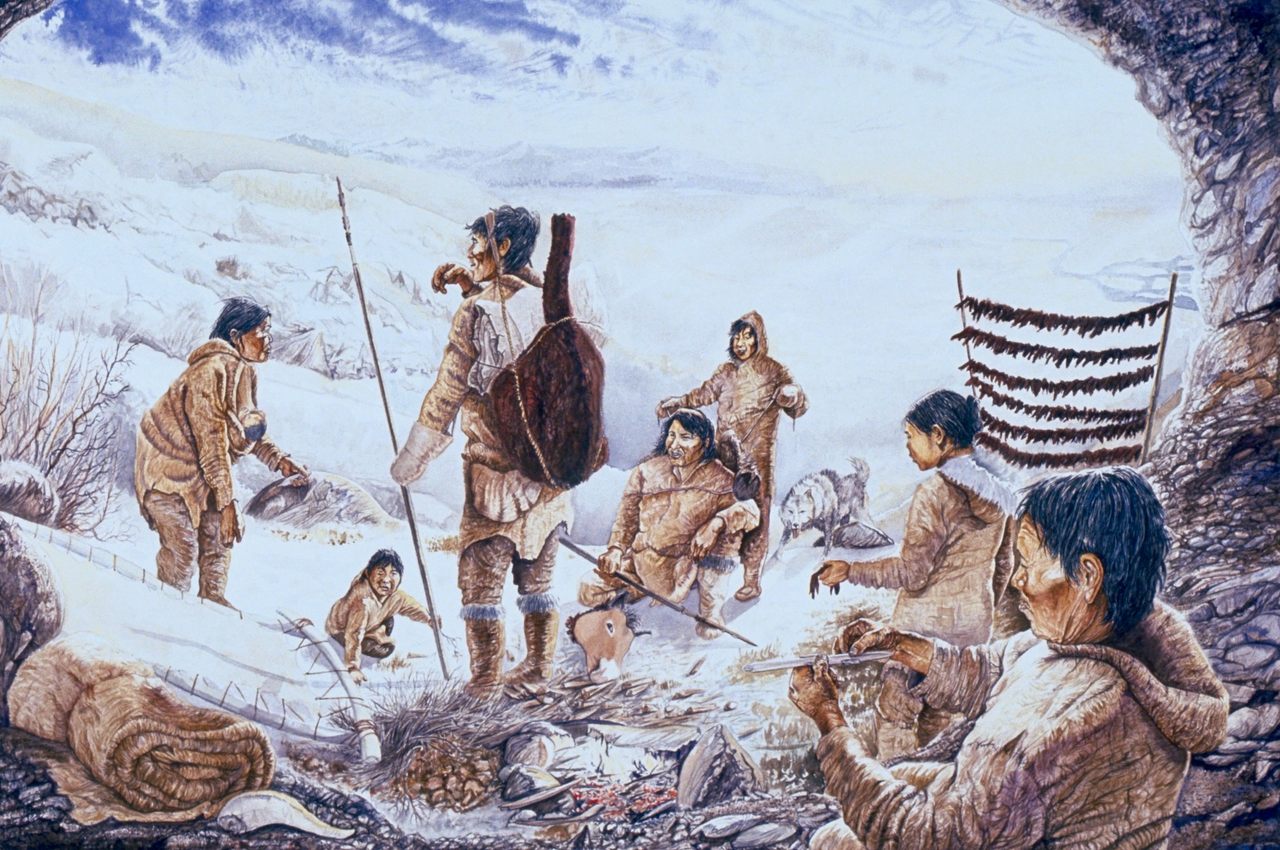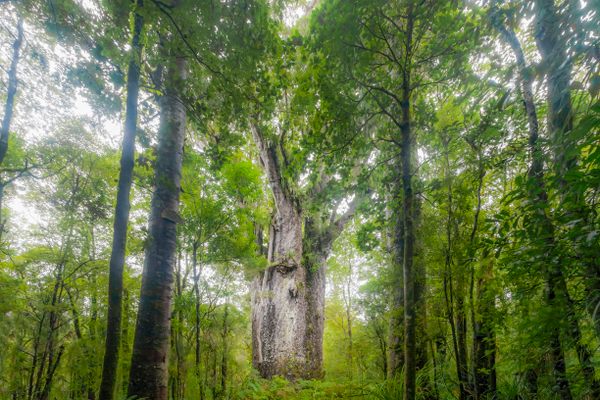Investigating Ice Age America’s Ancient Abattoir
Scientists know people were in Yukon 24,000 years ago. But what were they doing there?
This article is from Hakai Magazine, an online publication about science and society in coastal ecosystems. Read more stories like this at hakaimagazine.com.
During the last ice age, wooly mammoths, bison, caribou, and herds of fuzzy, stocky horses roamed the tundra-like grasslands of Beringia—a now-inundated landmass that once connected Siberia to Alaska and Yukon—munching vegetation and running from predators like steppe lions, bears, and wolves. Humans were living and hunting in Beringia at this time, too. From the Bluefish Caves, three hollows in a remote limestone ridge in northern Yukon, archaeologists have unearthed some of the oldest known signs of human occupation in North America. Today, these caves are providing scientists with a glimpse into the lives of the Beringian hunters who used them nearly 24,000 years ago.
Archaeologists have long debated how and when people entered the Americas. Throughout the 20th century, the mainstream hypothesis was that the Clovis people were the first to pass into Alaska about 13,000 years ago. Archaeologists who presented earlier dates for humans’ arrival were dismissed by many of their peers, and the sites they studied disregarded.
One of the archaeologists whose life’s work was all but overlooked was Jacques Cinq-Mars, a Canadian archaeologist who worked with the Canadian Museum of History in Québec. Stemming from his excavations between 1977 and 1987 at the Bluefish Caves, located on Van Tat Gwich’in First Nation territory in northwestern Yukon, Cinq-Mars unearthed evidence that the Clovis people were not the first to enter the Americas. Through his research, he concluded that hunters were using the site some 24,000 years ago. But Cinq-Mars, who died in November 2021, was met with skepticism, and his findings were questioned for decades.
Today, the Clovis first model is outmoded among most archaeologists, and older sites are widely accepted. But some archaeologists’ commitment to the hypothesis means the field now has a substantial amount of catching up to do.

One example of this ongoing rectification is the work being done by Lauriane Bourgeon, a French archaeologist at the University of Kansas. Bourgeon has spent much of her career re-examining and dating the Bluefish Caves collection—which includes a small number of tools and 36,000 animal bones—to clarify the history of the contentious site.
Her research has shown, for instance, that at least 15 bones from the Bluefish Caves were cut-marked by people as early as 23,500 years ago. Human-made cuts, she explains, are deep and thin with a V-shaped profile and typically correspond with strategic butchery. The oldest bone from the Bluefish Caves collection, a 23,500-year-old horse jaw, for example, has long, straight cuts on the inner side consistent with efforts to remove muscle.
Having already confirmed Cinq-Mars’s assertions that people were using the Bluefish Caves so long ago, Bourgeon has shifted the scope of her work: now, she’s trying to figure out what they were doing there.
Bourgeon’s examination of the Bluefish Caves collection shows that most of the bones are from Beringian, or Yukon, horses. These furry animals were smaller than modern horses and likely roamed in herds with one male and many females. The Beringian horse went extinct about 14,000 years ago, possibly due to human pressure and climate change, she says.
That most of the bones are from healthy adult horses, says Bourgeon, is “typical of human hunting”—in contrast, carnivores normally target vulnerable individuals. The caves are also unusually full of pelvises and other heavy bones. Based on this, along with the low number of stone tools and the lack of a hearth, Bourgeon and her colleague, Ariane Burke at the University of Montreal in Quebec, argue the Bluefish Caves were most likely used as a temporary camp by hunters mainly targeting Beringian horses.

These ice age hunters, Bourgeon explains, would have carried the horse carcasses to the caves to be butchered. They would strategically strip the largest bones of meat and marrow, and leave them behind when they’d make the trek back to a residential campsite.
Brandon Kyikavichik, a Van Tat Gwich’in heritage researcher who translates oral histories, says based on his knowledge of traditional hunting practices and his ancestors’ lives during the last ice age, Bourgeon’s interpretation of how the caves were used “makes a lot of sense.”
“The land was way different” back when hunters were using the Bluefish Caves, Kyikavichik explains. At this time, he says, his ancestors were tormented by giant animals. That is, until a hero known to the Van Tat Gwich’in as Ch’ataiiyuukii arrived from the ocean and “made the world more hospitable for humans,” Kyikavichik explains. Ch’ataiiyuukii became a leader, and showed the Van Tat Gwich’in how to map the stars and predict animal behavior. Then, according to one story, Ch’ataiiyuukii floated up to become a constellation.
“Our history is rich,” Kyikavichik says. “It goes back thousands of years [and] the stories are told with passion.” He notes that the Van Tat Gwich’in have always been involved in archaeological work in the region and, using their histories, could help identify sites for future excavations.
Finding physical evidence of the small human population that lived in Beringia during the last ice age, however, is challenging. People were likely nomadic and most of the land is now underwater. Though “the human signal is very low” at the Bluefish Caves, Bourgeon says, it’s clear people were there several times.

Bourgeon has plans to conduct further excavations at the site. She’s also in the process of confirming that the sediment layers in the caves are indeed in chronological order, as Cinq-Mars posited. “If I can … provide a relative age for the stone tools, then Bluefish Caves might be more accepted by the scientific community,” Bourgeon says.
Tom Dillehay, an archaeologist at Vanderbilt University in Tennessee who was not involved in the study, says that while there are still questions about the Bluefish Caves, the evidence of human activity “is becoming more convincing.”
He would like to see confirmation that the soil layers in the caves haven’t been disturbed, as well as further excavations at the site for indisputable proof of human presence. While most caves have been disrupted to some degree by natural or human causes, Dillehay says, he’s always thought some sections of the Bluefish Caves’ soil appeared relatively intact and that the radiocarbon dates were reliable.
Like Cinq-Mars, Dillehay came up against opposition from archaeologists who favored the Clovis first hypothesis in the late 1970s when he presented dates from Monte Verde, a pre-Clovis archaeological site in Chile. “I was surprised how violent it became,” he says. Even today, with the Clovis first model having largely fallen out of favor, there are still some who defend it vociferously, he adds.
Dillehay remembers Cinq-Mars as “a sincere and dedicated scientist” who left a legacy of patience.
Bourgeon started her research at the Bluefish Caves believing that people weren’t in North America during the last ice age, but quickly realized that Cinq-Mars was right. Though she met him only a few times, and wishes she’d had more opportunities to speak with him before he passed, Bourgeon is glad he lived to see her efforts confirm his research.
“I wish I had known him more,” Bourgeon says. “It’s always nice to spend some time with an archaeologist as good as he was.”









































Follow us on Twitter to get the latest on the world's hidden wonders.
Like us on Facebook to get the latest on the world's hidden wonders.
Follow us on Twitter Like us on Facebook